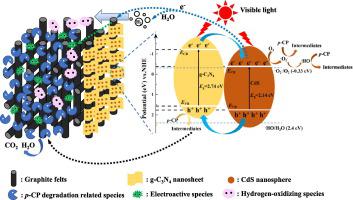Science of the Total Environment ( IF 8.2 ) Pub Date : 2021-10-16 , DOI: 10.1016/j.scitotenv.2021.151006 Hefei Shi 1 , Xinbai Jiang 1 , Yang Li 1 , Dan Chen 1 , Cheng Hou 1 , Zhenhua Zhang 2 , Qian Zhang 3 , Jinyou Shen 4

|
p-chlorophenol (p-CP), one of the highly toxic chlorinated organic compounds, is recalcitrant in conventional biodegradation process. This study reported a synergistic degradation protocol of 3D semiconductor-microbe interfaces, in which graphite felts (GF) and CdS/g-C3N4 nanocomposites were chosen as the carrier and semiconductor for enhanced p-CP degradation. Based on microstructure, photoelectrochemical and degradation performance analysis, the optimal CdS content in CdS/g-C3N4 nanocomposites was 10 wt%. The efficiencies of p-CP and TOC removal in bio-photodegradation system were as high as 95% and 77% without extra electron acceptors/donors, which were far better than those in traditional photodegradation and biodegradation system. High-throughput sequencing analysis suggested that p-CP degradation related species (Chryseobacterium, Stenotrophomonas and Rhodopseudomonas), electroactive species (Chryseobacterium, Stenotrophomonas, Hydrogenophaga and Cupriavidus) and hydrogen-utilizing species (Hydrogenophaga and Cupriavidus) were enriched at 3D semiconductor-microbe interfaces. The enrichment of functional species played a crucial role for p-CP removal and mineralization at 3D semiconductor-microbe interfaces. Moreover, the mechanism of enhanced p-CP bio-photodegradation at 3D semiconductor-microbe interfaces was investigated by utilizing Phylogenetic Investigation of Communities by Reconstruction of Unobserved States 2 (PICRUSt2). The results showed that the genes involved in p-CP biodegradation, hydrogen metabolism and extracellular electron transfer were remarkably enriched. Possible mechanism for enhancement of p-CP degradation in bio-photodegradation system was proposed, in which photocatalytic H2 and photoelectron transfer played an important role for enhancing p-CP mineralization by microbes. 3D semiconductor-microbe interfaces could maintain excellent performance for p-CP degradation after long-term operation, which provide a potential alternative for the enhanced treatment of wastewater containing p-CP.
中文翻译:

通过 CdS/g-C3N4 3D 半导体-微生物界面增强对氯苯酚的生物光降解
对氯苯酚 ( p- CP) 是一种剧毒的氯化有机化合物,在常规生物降解过程中是顽固的。该研究报告了 3D 半导体-微生物界面的协同降解方案,其中选择石墨毡 (GF) 和 CdS/gC 3 N 4纳米复合材料作为载体和半导体以增强p -CP 降解。基于微观结构、光电化学和降解性能分析,CdS/gC 3 N 4纳米复合材料中的最佳CdS含量为10 wt%。p的效率-CP 和 TOC 在生物光降解系统中的去除率分别高达 95% 和 77%,无需额外的电子受体/供体,远优于传统的光降解和生物降解系统。高通量测序分析表明,p -CP降解相关的物种(金黄,嗜和红假单胞菌属),电活性物质(金黄,嗜,Hydrogenophaga和钩虫贪铜)和利用氢物种(Hydrogenophaga和钩虫贪铜) 在 3D 半导体-微生物界面富集。功能物种的富集对3D 半导体-微生物界面处的p- CP 去除和矿化起着至关重要的作用。此外,通过利用未观察状态重建 2 (PICRUSt2) 进行的群落系统发育研究,研究了 3D 半导体-微生物界面增强p -CP 生物光降解的机制。结果表明,参与p- CP生物降解、氢代谢和细胞外电子转移的基因显着富集。提出了在生物光降解系统中促进p -CP 降解的可能机制,其中光催化 H 2光电子转移对增强微生物对 p- CP 的矿化起着重要作用。3D 半导体-微生物界面可以在长期运行后保持优异的p -CP 降解性能,为含p -CP废水的强化处理提供了潜在的替代方案。











































 京公网安备 11010802027423号
京公网安备 11010802027423号